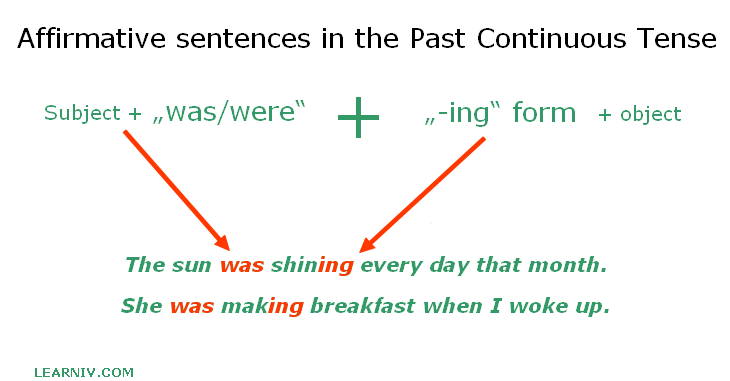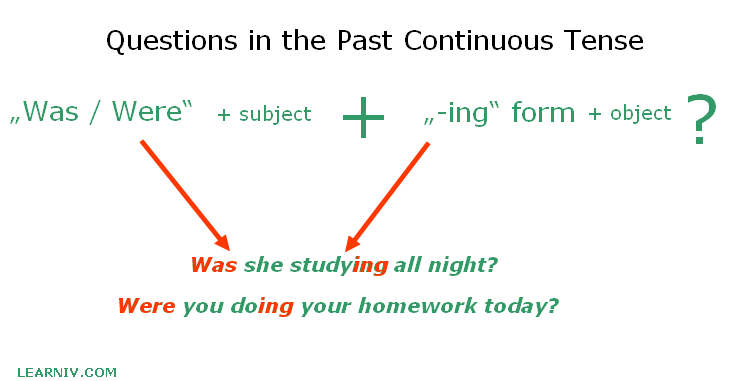
In the realm of English grammar, the past continuous tense serves as a powerful tool to describe actions or events that were in progress at a specific time in the past. Often referred to as the past progressive tense, understanding its structure is essential for effective communication and storytelling. In this blog post, we will delve into the past continuous structure, exploring its components and learning how to wield it proficiently in our language pursuits.
The Building Blocks
The past continuous tense is formed using two main components: the past tense of the auxiliary verb “to be” (was/were) and the base form of the main verb with the -ing suffix.
Affirmative Structure
The affirmative past continuous tense is composed of the 2nd form of the verb „to be“ and the verb in its basic form with the suffix – ing.
While in the past simple we do not distinguish between a person or the number of subjects, in the past continuous tense it is different. We use the past tense form of the verb „to be“, meaning we combine „was/were“ with the base form verb + -ing.
This time it is easier in the sense that we do not have to memorize irregular forms of verbs like we had to for the past simple or past perfect tense. The only thing we need to know is how to use „was/were“and to know how to add the suffix – ing.
The complete sentence would be as follows:
Subject + was/were + (verb in base form + –ing) + object.
Example:
- “He was studying” for his exams.
Negative Structure
To describe the negative meaning of a sentence it is necessary to add negative (not) in front of „was/were“. This means that to describe the negative meaning, we use „was not“ or „were not“. We can also use its shorter form „wasn’t/weren‘t“ in combination with the base form the verb + the suffix – ing.
If you want to use the negative meaning in a formal conversation, use „was not“. This form is more formal than the shorter form and is therefore most suitable for the situation.
When we are talking to friends or family, we can use short forms. Short forms are often used in conversation with people you know and when it is not a formal situation.
The complete sentence would be as follows:
Subject + was/were not + (base form of verb + –ing) + object.
Example:
- “They were not playing” soccer in the park.
Interrogative Structure
To form a question in the past continuous tense, we have to put the verb „was/were“ at the beginning of the sentence, in front of the subject. The rest of the sentence is similar to affirmative sentences. We are still using the verb in its base form in combination with the suffix –ing.
The complete sentence would be as follows:
Was / Were + subject + (verb in a base form + -ing) + object?
Example:
- “Were you watching” TV when the power went out?
Using Past Continuous in Context
Ongoing Actions in the Past
The past continuous tense allows us to vividly portray actions that were unfolding at a specific moment in the past. Whether it’s someone studying diligently, children playing gleefully, or friends laughing heartily, the past continuous brings life to our narratives.
Example:
- “She was dancing gracefully at the party.”
Simultaneous Actions
This tense can describe two or more actions happening simultaneously in the past, providing a dynamic account of events that occurred together.
Example:
- “While I was cooking dinner, he was setting the table.”
Interrupted Actions
The past continuous is perfect for describing actions that were interrupted by another event in the past.
Example:
- “They were walking in the park when it started to rain.”
Adverbs and Time Expressions:
Adverbs and time expressions are often used with the past continuous tense to provide additional context and detail. Adverbs of frequency, duration, manner, and time can enrich our sentences and paint a more comprehensive picture of the ongoing actions in the past.
Example:
- “She was always smiling during the performance.”
- “They were working on the project constantly for days.”
- “The children were playing happily in the playground.”
Conclusion
Mastering the past continuous structure opens a world of expressive possibilities in English language usage. This versatile tense breathes life into our stories, painting a vivid picture of ongoing actions and events in the past. With a solid grasp of its components and their interplay, we can effortlessly weave dynamic narratives, capturing the essence of past moments. So, let’s embrace the past continuous tense and embark on a journey of evocative storytelling and effective communication!
More examples of Past continuous sentences
More examples:
- 10 examples of Past Continuous Tense Sentences
- Adverbs of past continuous tense
- Past continuous tense examples
- Past continuous tense verbs





